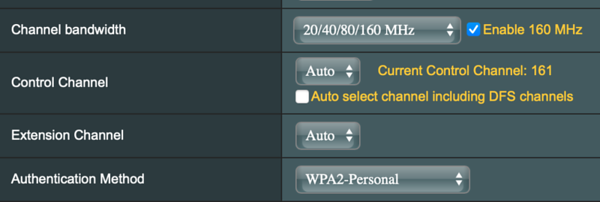Hi everyone,
I’m a long time owner of an Apple AirPort Extreme and have a house full of mostly Apple devices. I just replaced my Airport Extreme with the ASUS RT-AX86U router. It’s basically setup with all default settings however I did separate my 2.4 and 5 GHz bands with different SSIDs.
I’m hoping to get some help with some strange and frustrating behavior I’ve been encountering. The main issue is that our Apple devices seem to randomly disconnect from wifi and prompt on-screen with “Incorrect Password”. Entering the password again just results in the same prompt coming up. The only solution is to reset all network settings on the device and join the network again. Then at a later random time, it will happen all over again.
This is especially frustrating with devices such as the HomePod minis as once they lose their network connection, they must be completely reset in order to gain access to them again.
If I reboot the router, some of these devices will simply not auto-join the network again as they used to with my AirPort Extreme.
I generally have good coverage in my house with the one router. However, I’ve observed that the RSSI number that is reported in the router admin pages is always much lower than the actual that is reported by the devices. For example, my MacBook Pro will show an RSSI of -59 and the router will be reporting -70.
Likewise, a device that is literally 6 feet from the router will report an RSSI of -30 and the router will report it as -45. Is that normal for these routers?
Lastly, I use the wifi network for AirPlay as well and I’ve noticed several 1 second long audio drop outs and clicks and pops since starting to use this ASUS router.
After reading so many great reviews of this router, I’m somewhat disappointed in my experience with it so far.
I’m still within my return period with Best Buy so I’m not going to keep this router if it doesn’t play nicely with Apple devices. But I’d like to try and resolve the issues if I can. I’ve been spoiled for years with the “set it and forget it” nature of the AirPort Extreme which just ran solidly for years.
Thank you in advance for any replies.
I’m a long time owner of an Apple AirPort Extreme and have a house full of mostly Apple devices. I just replaced my Airport Extreme with the ASUS RT-AX86U router. It’s basically setup with all default settings however I did separate my 2.4 and 5 GHz bands with different SSIDs.
I’m hoping to get some help with some strange and frustrating behavior I’ve been encountering. The main issue is that our Apple devices seem to randomly disconnect from wifi and prompt on-screen with “Incorrect Password”. Entering the password again just results in the same prompt coming up. The only solution is to reset all network settings on the device and join the network again. Then at a later random time, it will happen all over again.
This is especially frustrating with devices such as the HomePod minis as once they lose their network connection, they must be completely reset in order to gain access to them again.
If I reboot the router, some of these devices will simply not auto-join the network again as they used to with my AirPort Extreme.
I generally have good coverage in my house with the one router. However, I’ve observed that the RSSI number that is reported in the router admin pages is always much lower than the actual that is reported by the devices. For example, my MacBook Pro will show an RSSI of -59 and the router will be reporting -70.
Likewise, a device that is literally 6 feet from the router will report an RSSI of -30 and the router will report it as -45. Is that normal for these routers?
Lastly, I use the wifi network for AirPlay as well and I’ve noticed several 1 second long audio drop outs and clicks and pops since starting to use this ASUS router.
After reading so many great reviews of this router, I’m somewhat disappointed in my experience with it so far.
I’m still within my return period with Best Buy so I’m not going to keep this router if it doesn’t play nicely with Apple devices. But I’d like to try and resolve the issues if I can. I’ve been spoiled for years with the “set it and forget it” nature of the AirPort Extreme which just ran solidly for years.
Thank you in advance for any replies.
Last edited:


